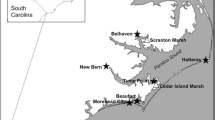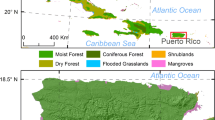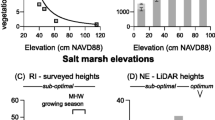Abstract
Recent die-off of coastal forests has been attributed primarily to the effects of sea level rise by correlation with tide-gage records. Due to the temporal and spatial scales involved, direct monitoring of sea level rise impacts is challenging and its attribution can be confounded by both land-use history and species interactions. Here we present experimental evidence for a micro-tidal, oligohaline estuarine system that the location of coastal treeline is determined by both environmental controls and positive and negative species interactions. We conducted field surveys and a transplant experiment to determine the controls on pine seedling establishment and survival along a salinity and flooding gradient. Using a two-way changepoint model we determined that sawgrass cover (Cladium jamaicense) and salinity concentrations interact to control natural pine regeneration (Pinus taeda). The long-term removal of sawgrass resulted in increased soil salinity and high rates of (planted) pine seedling mortality. In contrast, pine seedlings planted directly under sawgrass were able to survive at the same level as upland forest plots because of reduced salinity levels. This research provides evidence that sawgrass can facilitate pine seedling survival, but also suggests that either competitive exclusion by sawgrass or dispersal limitations prevent initial pine seedling regeneration. We propose that forest dynamics are closely coupled to fire, which consumes sawgrass biomass and reduces competition between pine seedlings and grass. Following fire, pine seedling establishment and the regrowth of sawgrass facilitates long-term pine seedling survival. Under this scenario, recent marsh invasion into coastal forests may not necessarily represent a permanent state change in locations where abiotic stress is not the only determinant for community composition.







Similar content being viewed by others
References
Bertness MD (1991) Zonation of Spartina patens and Spartina alterniflora in a New-England Salt-Marsh. Ecology 72:138–148. doi:10.2307/1938909
Bertness MD, Ellison AM (1987) Determinants of pattern in a New-England salt-marsh plant community. Ecol Monogr 57:129–147. doi:10.2307/1942621
Bruno JF, Stachowicz JJ, Bertness MD (2003) Inclusion of facilitation into ecological theory. Trends Ecol Evol 18:119–125. doi:10.1016/S0169-5347(02)00045-9
Callaway RM, Brooker RW, Choler P, Kikvidze Z, Lortie CJ, Michalet R et al (2002) Positive interactions among alpine plants increase with stress. Nature 417:844–848. doi:10.1038/nature00812
Christensen NL (2000) Vegetation of the coastal plain of the southeastern United States. In: Barbour M, Billings WD (eds) Vegetation of North America. Cambridge University Press, Cambridge
Church JA, Gregory JM, Huybrechts P, Kuhn M, Lambeck K, Nhuan MT et al (2001) Changes in sea level. In: Houghton JT, Ding Y, Griggs DJ, Noguer M, Van der Linden PJ, Xiaou D (eds) Climate change 2001: the scientific basis. Cambridge University Press, Cambridge
Connell JH, Slatyer RO (1977) Mechanisms of succession in natural communities and their role in community stability and organization. Am Nat 111:1119–1144. doi:10.1086/283241
Conner WH, Askew GR (1992) Response of baldcypress and loblolly-pine seedlings to short-term saltwater flooding. Wetlands 12:230–233
Crain CM, Silliman BR, Bertness SL, Bertness MD (2004) Physical and biotic drivers of plant distribution across estuarine salinity gradients. Ecology 85:2539–2549. doi:10.1890/03-0745
Cullen LE, Stewart GH, Duncan RP, Palmer JG (2001) Disturbance and climate warming influence New Zealand Nothofagus tree-line population dynamics. J Ecol 89:1061–1071. doi:10.1111/j.1365-2745.2001.00628.x
Esper J, Schweingruber FH (2004) Large-scale treeline changes in Siberia. Geophys Res Lett 31:L06202. doi:10.1029/2003GL019178
Frost CC (1995) Presettlement fire regimes in southeastern marshes, peatlands and swamps. In: Cerulean SI, Engstrom RT (eds) Fire in wetlands: a management perspective, vol 19. Tall Timbers Research Station, Tallahassee, pp 39–60
Gagnon JA (1999) Soil survey of Hyde County. United States Department of Agriculture, Natural Resources Conservation Service, North Carolina
Gelman A (2005) Analysis of variance-why it is more important than ever (with discussions). Ann Sci 33:1–53
Gelman A, Tuerlinckx F (2000) Type S error rates for classical and Bayesian single and multiple comparison procedures. Comput Stat 15:373–390. doi:10.1007/s001800000040
Grime JP (1977) Competitive exclusion in herbaceous vegetation. Nature 242:344–347. doi:10.1038/242344a0
Hackney CT, de la Cruz AA (1981) Effects of fire on brackish marsh communities: management implications. Wetlands 1:75–87
Holtmeier FK, Broll G (2005) Sensitivity and response of northern hemisphere altitudinal and polar treelines to environmental change at landscape and local scales. Glob Ecol Biogeogr 14:395–410. doi:10.1111/j.1466-822X.2005.00168.x
Kennedy PG, Sousa WP (2006) Forest encroachment into a Californian grassland: examining the simultaneous effects of facilitation and competition on tree seedling recruitment. Oecologia 148:464–474. doi:10.1007/s00442-006-0382-7
Korner C (1998) A re-assessment of high elevation treeline positions and their explanation. Oecologia 115:445–459. doi:10.1007/s004420050540
Kozlowski T (1997) Responses of woody plants to flooding and salinity. Tree Physiol Monogr 1:1–29
McLemore BF (1971) Light requirements for germination of Loblolly pine seeds. For Sci 17:285–286
Moorhead KK, Brinson MM (1995) Response of wetlands to rising sea level in the lower coastal plain of North Carolina. Ecol Appl 5:261–271. doi:10.2307/1942068
Mueller-Dombois D, Ellenberg H (1974) Aims and methods of vegetation ecology. Wiley, New York
Parmesan C, Yohe G (2003) A globally coherent fingerprint of climate change impacts across natural systems. Nature 421:37–42. doi:10.1038/nature01286
Pennings SC, Moore DJ (2001) Zonation of shrubs in western Atlantic salt marshes. Oecologia 126:587–594. doi:10.1007/s004420000548
Pennings SC, Selig ER, Houser LT, Bertness MD (2003) Geographic variation in positive and negative interactions among salt marsh plants. Ecology 84:1527–1538. doi:10.1890/0012-9658(2003)084[1527:GVIPAN]2.0.CO;2
Pennings SC, Grant MB, Bertness MD (2005) Plant zonation in low-latitude salt marshes: disentangling the roles of flooding, salinity and competition. J Ecol 93:159–167. doi:10.1111/j.1365-2745.2004.00959.x
Poulter B (2005) Interactions between landscape disturbance and gradual environmental change: plant community migration in response to fire and sea level rise. Dissertation, Duke University, Durham, North Carolina
Poulter B, Halpin PN (2008) Raster modeling of coastal flooding from sea level rise. Int J Geogr Inf Sci 22:167–182. doi:10.1080/13658810701371858
Poulter B, Christensen NL, Qian SS (2008) Tolerance of Pinus taeda and Pinus serotina to low salinity and flooding: Implications for equilibrium vegetation dynamics. J Veg Sci 19:15–22
Qian SS, Shen Z (2007) Ecological applications of multilevel analysis of variance. Ecology 88:2489–2495. doi:10.1890/06-2041.1
Qian SS, King RS, Richardson CJ (2003a) Two statistical methods for the detection of environmental thresholds. Ecol Modell 166:87–97. doi:10.1016/S0304-3800(03)00097-8
Qian SS, Stow CA, Borsuk ME (2003b) On Monte Carlo methods for Bayesian inference. Ecol Modell 159:269–277
Ross MS, O’Brien JJ, Sternberg SL (1994) Sea-level rise and the reduction in pine forests in the Florida Keys. Ecol Appl 4:144–156. doi:10.2307/1942124
Schafale MP, Weakley AS (1990) Classification of the natural communities of North Carolina. North Carolina Natural Heritage Program, Division of Parks and Recreation, North Carolina Department of Environment, Health, and Natural Resources, Raleigh, North Carolina
Shelton MG, Cain MD (2002) Recovery of 1-year-old loblolly pine seedlings from simulated browse damage. Can J For Res-Revue Canadienne De Rech Forestiere 32:373–377. doi:10.1139/x01-193
Smith JB, Schellnhuber HJ, Mirza MMQ (2001) Vulnerability to climate change and reasons for concern: a synthesis. In: McCarthy JJ, Canziani O, Leary NA, Dokken DJ, White KS (eds) Climate change 2001: impacts: adaptation and vulnerability. Cambridge University Press, UK, pp 913–970
Stevens GC, Fox JF (1991) The causes of treeline. Annu Rev Ecol Syst 22:177–191. doi:10.1146/annurev.es.22.110191.001141
Williams K, Meads MV, Sauerbrey DA (1998) The roles of seedling salt tolerance and resprouting in forest zonation on the west coast of Florida, USA. Am J Bot 85:1745–1752. doi:10.2307/2446509
Williams K, Ewel KC, Stumpf RP, Putz FE, Workman TW (1999) Sea-level rise and coastal forest retreat on the west coast of Florida, USA. Ecology 80:2045–2063
Acknowledgments
We appreciate permission granted to conduct this research from Swanquarter National Wildlife Refuge, Hyde County, North Carolina. The assistance from Steve Buback, Jason Davis, Nathan Emery, Julie Guyenet, Scott Loarie, Melissa Reif, Adam Spiller, and Paul Stoy was invaluable for field research and data collection. B. Poulter was supported by a Fellowship from the Forest History Society and by NASA Headquarters under the Earth System Science Fellowship Grant NGT5-30472. S.·S. Qian was supported by a US EPA’s STAR grant (# RD83244701). Additional financial support for fieldwork was provided by the North Carolina Seagrant Program.
Author information
Authors and Affiliations
Corresponding author
Rights and permissions
About this article
Cite this article
Poulter, B., Qian, S.S. & Christensen, N.L. Determinants of coastal treeline and the role of abiotic and biotic interactions. Plant Ecol 202, 55–66 (2009). https://doi.org/10.1007/s11258-008-9465-3
Received:
Accepted:
Published:
Issue Date:
DOI: https://doi.org/10.1007/s11258-008-9465-3




